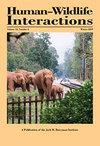野猪的近距离接触
IF 0.9
4区 环境科学与生态学
Q4 BIODIVERSITY CONSERVATION
引用次数: 0
摘要
那是考艾岛的一个深夜,我对驾驶执照的自由感到新鲜。我和一个朋友一起参加了一个活动,我以岛上生活的速度在一条我们已经走过一千次的街道上开车。在一个光线昏暗的下坡上,在一个即使在白天也很危险的急转弯处,车头灯照在路上的两个庞然大物上。我猛踩我家的福特Escort型轿车的刹车。在一个死胡同里,我们摇摇晃晃,谢天谢地没有被追尾,我们坐下来等着——两个十几岁的女孩差点撞上两只挡住黑暗道路的巨大野猪(Sus scrofa)。怎么能错过宵禁。尽管这种遭遇在大多数当地人的日常生活中很罕见,但野猪是夏威夷群岛上最丰富的入侵大型脊椎动物物种之一,对当地植被和岛屿生态系统造成了破坏(Hess et al. 2020)。然而,这个物种在岛上的起源故事直到最近才开始展开。研究将夏威夷野猪的遗传标记与波利尼西亚祖先的较小猪种联系起来,表明波利尼西亚航海家而不是詹姆斯·库克船长将猪引入夏威夷群岛的时间比最初认为的早了几个世纪(Linderholm et al. 2016)。随着时间的推移,波利尼西亚猪,被称为pua夏威夷猪,“与1770年代开始由探险家和殖民者引入的多种家猪,亚洲野猪和欧洲野猪反复杂交”(Hess et al. 2020, 405)。猪们也以另一种方式长大了——每次都在复述我在那个黑暗而危险的夜晚发生的故事。今天,夏威夷野猪的历史与其文化意义交织在一起,这既可以为野生动物管理实践提供信息,也可以使其复杂化。Lohr等人(2014)调查了来自6个岛屿的夏威夷居民对野猪和其他狩猎物种的看法。尽管猎猪很常见,猪消费是夏威夷传统的一部分,但所有岛屿上非猎猪群体的受访者普遍希望减少猪的数量。受访者还在研究中给猪和其他物种赋予了不同程度的文化价值。这种可变性表明需要本地化的管理方法(Lohr et al. 2014)。以离散岛屿社区为重点的其他人文方面研究可以进一步促进平衡的管理计划。夏威夷和考艾岛野生动物管理的特殊性让我想知道:野生动物专业人士如何在有效管理和本地化的价值观和观点之间取得更大的平衡?学术课程或专业发展培训在多大程度上适应了野生动物专业的社会文化因素?不同的声音,每个人都有利害关系,如何才能团结一致,朝着物种管理和积极的人类与野生动物互动的最终目标,以及与实现这一目标的文化意识过程同等重要的感知?我自己从野生动物管理领域之外的角度来处理这些问题,但我关注的是那些了解管理策略的人和那些将文化联系起来的人的交集。在这样一个复杂的交叉路口,碰撞的可能性总是需要快速和小心的操作。因为我把我在岛上的成长经历和我在《人类与野生动物互动》杂志的编辑角色联系在一起,所以我对该杂志即将出版的关于岛屿入侵者的特刊感到特别兴奋(见本期论文征集)。跨越世界各地岛屿的研究和管理将有助于扩大本地化方法,使其远远超出其原产地。我为地球上那些常常被边缘化的小地方能够对野生动物管理做出如此有意义和有影响力的贡献而感到自豪。这个领域似乎有无穷无尽的人类与野生动物之间的冲突需要解决,但正如一句流行的夏威夷谚语所说:“所有人共同努力,没有什么任务是艰巨的。”后台本文章由计算机程序翻译,如有差异,请以英文原文为准。
Close Encounters of the Feral Swine
It was late one night on the island of Kauai, and I was fresh with the freedom of a driver’s license. Leaving an event with a friend as my passenger, I drove at the speed of island life on a street we had traveled a thousand times. On a downhill slope, dimly lit, at a sharp curve quite dangerous even by day, the headlights shone on 2 huge masses in the road. I slammed on the brakes of my family’s Ford Escort. At a dead stop, shaken up, and grateful to not be rear-ended, we sat and waited—2 teenage girls at a near-collision with 2 enormous wild pigs (Sus scrofa) blocking the dark road. What a way to miss curfew. Although such encounters are rare in the daily lives of most locals, wild pigs are among the most abundant invasive large vertebrate species in the Hawaiian Islands, causing damage to native vegetation and island ecosystems (Hess et al. 2020). Yet, the origin story of this species in the islands has only recently been unfolding. Studies linked genetic markers of Hawaiian wild pigs to smaller pig species of Polynesian ancestry, indicating that Polynesian voyagers rather than Captain James Cook introduced pigs to the Hawaiian Islands several centuries earlier than originally thought (Linderholm et al. 2016). Over time, the Polynesian pig, called puaʻa, “repeatedly interbred with multiple varieties of domestic swine, Asiatic wild boar, and European wild boar introduced by explorers and colonists beginning in the 1770s” (Hess et al. 2020, 405). The pigs grew larger in another way, too—with each retelling of my story from that dark and dangerous night. Today, the history of the wild pig in Hawaii intertwines with its cultural significance, which can both inform and complicate wildlife management practices. Lohr et al. (2014) examined perceptions of wild pigs and other game species among Hawaii residents from 6 islands. Although pig hunting is common and pig consumption is part of Hawaiian tradition, respondents in non-hunter groups across all islands generally wanted pig abundance to decrease. Respondents also assigned varying levels of cultural value to pigs and other species in the study. This variability indicates a need for localized management approaches (Lohr et al. 2014). Additional human dimensions research focused on discrete island communities can further facilitate balanced management plans. The specificity of wildlife management in Hawaii, and further, on Kauai, led me to wonder: how can wildlife professionals achieve a greater balance of effective management and localized values and opinions going forward? To what extent are academic curriculums or professional development trainings adapting to address sociocultural factors in the wildlife profession? How can multiple voices, each with something at stake, cohere toward end goals of species management and positive human–wildlife interactions and perceptions that hold equal weight with a culturally conscious process of getting there? I approach these questions from outside the field of wildlife management myself, but with an eye on the intersection of those who know the management strategies and those who connect the culture. At such a complex intersection, the possibility of collision will always require quick and careful maneuvering. Because I connect to both my island upbringing and my editorial role with Human–Wildlife Interactions, I am especially excited about the journal’s upcoming special issue on island invaders (see call for papers in this issue). The research and management, spanning islands around the world, will help amplify localized approaches far beyond their points of origin. I am proud of how the small and often marginalized places of this earth can be sites of such meaningful and influential contributions to wildlife management. Such a field has seemingly endless human–wildlife conflicts to address, but as a popular Hawaiian saying goes: ʻAʻohe hana nui ke alu ʻia—“no task is too big when done together by all.” The Back Page
求助全文
通过发布文献求助,成功后即可免费获取论文全文。
去求助
来源期刊

Human–Wildlife Interactions
Environmental Science-Nature and Landscape Conservation
CiteScore
2.80
自引率
0.00%
发文量
0
审稿时长
11 weeks
期刊介绍:
Human–Wildlife Interactions (HWI) serves the professional needs of the wildlife biologist and manager in the arena of human–wildlife conflicts/interactions, wildlife damage management, and contemporary wildlife management. The intent of HWI is to publish original contributions on all aspects of contemporary wildlife management and human–wildlife interactions with an emphasis on scientific research and management case studies that identify and report innovative conservation strategies, technologies, tools, and partnerships that can enhance human–wildlife interactions by mitigating human–wildlife conflicts through direct and indirect management of wildlife and increased stakeholder engagement. Our intent is to promote a dialogue among wildlife professionals concerning contemporary management issues. As such, we hope to provide a repository for wildlife management science and case studies that document and share manager experiences and lessons learned.
 求助内容:
求助内容: 应助结果提醒方式:
应助结果提醒方式:


